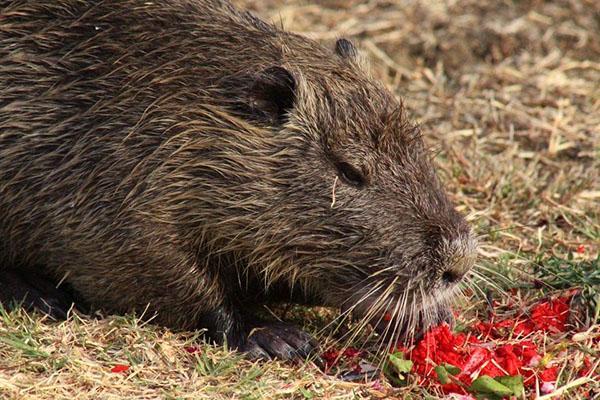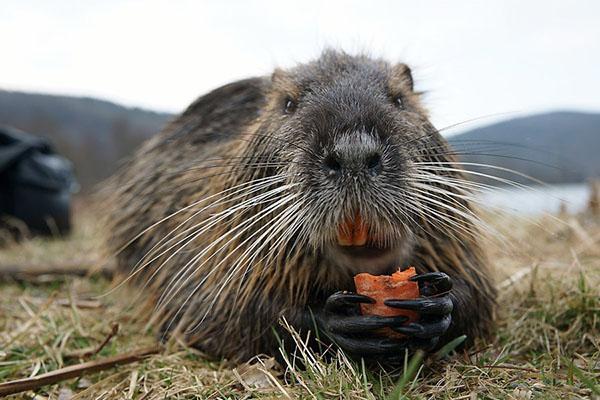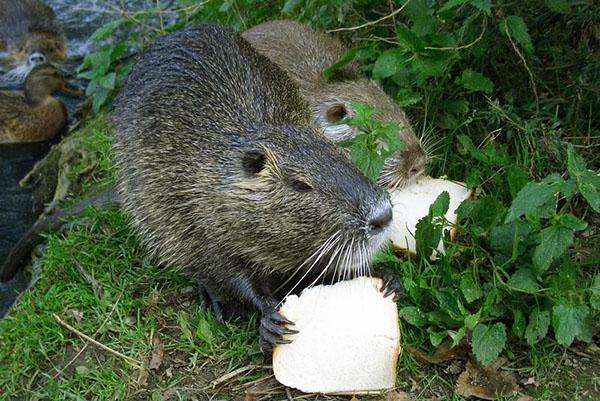Keeping and breeding nutria at home
 Nutria have long and very successfully grown in captivity. However, to call the cultivation of nutria mass, which, for example, is keeping chickens or rabbits, it is impossible, although interest in these animals is gradually growing.
Nutria have long and very successfully grown in captivity. However, to call the cultivation of nutria mass, which, for example, is keeping chickens or rabbits, it is impossible, although interest in these animals is gradually growing.
Unpretentious, easily getting used to various conditions of keeping and feeding, nutria are grown for the sake of delicious meat and valuable fur skins. Young growth of nutria for keeping at home is purchased at the age of 2-3 months. By this time, cute and rather friendly animals weigh a little less than one and a half kilograms, but by six months, with proper care and feeding, they grow up to 5–6 kg. By this time, nutria, which usually live up to seven years, mature for reproduction.
To obtain offspring, there should be from 4 to 6 females per male. Moreover, in each litter, there are from 5 to 18 cubs. In nature, nutria cubs appear at positive air temperatures. At home, females consistently bring 6-8 animals, giving two litters a year, regardless of the season.

These and other questions are sure to arise for those who plan to breed nutria at home as a business or have acquired fluffy animals for personal needs.
Conditions for the cultivation of nutria
 Until the moment when new residents arrive at the farm, nutria need to prepare housing, stock up on balanced food, take care of water and the appropriate temperature.
Until the moment when new residents arrive at the farm, nutria need to prepare housing, stock up on balanced food, take care of water and the appropriate temperature.
If the animals are well cared for and live in proper conditions, already at 5-7 months they reach 75-85% of the maximum possible weight and have high-quality fur.
If you are going to start breeding and keeping nutria at home, the owner of a backyard farm must remember that the animals need:
- in a reservoir, the capacity of which is calculated from 70-80 liters per animal;
- in clean water, which must be changed in a reservoir at least once every two days;
- in spacious durable cages, where there are no more than 2 animals per square meter;
- in maintaining a comfortable temperature of about 15-25 ° C:
- in a balanced feed with a predominance of juicy food and in fresh drinks.
 Protection made of thick fur allows the animals to withstand frosts up to 30 ° C, but even novice breeders should not allow this when breeding nutria at home. In cold weather, the paws and tail of rodents are often frostbite. In the summer heat, animals feel better if they have constant access to a reservoir.
Protection made of thick fur allows the animals to withstand frosts up to 30 ° C, but even novice breeders should not allow this when breeding nutria at home. In cold weather, the paws and tail of rodents are often frostbite. In the summer heat, animals feel better if they have constant access to a reservoir.
A video about nutria breeds, their breeding, maintenance and care of fluffy inhabitants of reservoirs will provide a lot of informative information. The clearly presented material will help you navigate when organizing your own farm for growing these interesting animals.
Feeding nutria when kept at home
When bred at home, nutria show themselves to be extremely unassuming pets both in terms of conditions of detention and in nutrition. The animals are almost omnivorous.The diet of these large rodents in central Russia includes grain, fresh grasses and hay, compound feed and root crops.
With a lack of juicy forages, which are most preferable, nutria do not disdain waste from grain processing, residues from the human table, weeds from the beds, young branches and other very simple food.
But to achieve the best growth and coat quality with a "casual" diet will not work.
 In order for the animals to develop really well, reproduce and flaunt in beautiful fur coats, they need:
In order for the animals to develop really well, reproduce and flaunt in beautiful fur coats, they need:
- the maximum amount of juicy, vitamin-rich feed;
- double meals with the main emphasis on morning feeding, during which nutria should receive up to 70% of the total daily feed;
- get a sufficient amount of vegetable and animal protein, providing a rapid increase in body weight and good quality wool;
- four times more fresh food than concentrated and dry food.
 For those who are just mastering the cultivation of nutria at home, the novice owners of these large rodents will be interested to know that the animals treat food in the water with a special appetite and interest. You can throw any root vegetables, vegetables, apples and grass.
For those who are just mastering the cultivation of nutria at home, the novice owners of these large rodents will be interested to know that the animals treat food in the water with a special appetite and interest. You can throw any root vegetables, vegetables, apples and grass.
Nutria Breeding Cages
It is not enough to have nutria on the farm, prepare enough feed for them and take care of acceptable living conditions. Often, novice owners of these rodents do not rejoice in new pets for long because of their own hindsight.
 Nutria, like otters, muskrats and beavers, are not averse to trying not only the food offered to them, but also their own cells, if they are made of wood. In a matter of hours, gnawing at racks or areas near the grates, the animals simply run away. Therefore, for this type of animal, it is better to equip reliable housing made of durable metal:
Nutria, like otters, muskrats and beavers, are not averse to trying not only the food offered to them, but also their own cells, if they are made of wood. In a matter of hours, gnawing at racks or areas near the grates, the animals simply run away. Therefore, for this type of animal, it is better to equip reliable housing made of durable metal:
- The cage walls and fences are made of mesh or fine mesh lattice, which provides good ventilation and helps to keep an eye on the animals.
- The floors can be either solid or slatted. In the latter case, you need to accurately select the size of the cell so that the animals do not get hurt.
A place for cages and walking nutria when breeding them at home is chosen so that the pets are not disturbed by drafts, and curious animals have no opportunity to escape.
If, nevertheless, nutria were able to overcome all obstacles and left the cage, following instinct, they go to the nearest body of water. Here they can be lured with juicy roots. And in some cases, accustomed to the place where they are fed, the animals themselves find their way to the farm.
 The video about the cultivation of nutria at home tells in detail about all the nuances of caring for animals, about the features of arranging housing for rodents and choosing a diet.
The video about the cultivation of nutria at home tells in detail about all the nuances of caring for animals, about the features of arranging housing for rodents and choosing a diet.